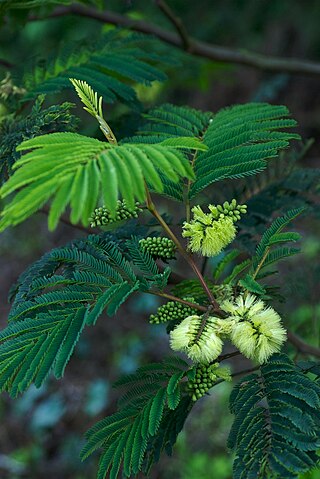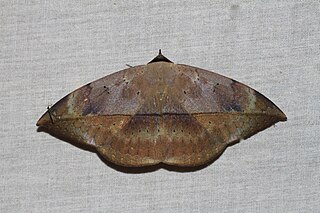
Albizia is a genus of more than 160 species of mostly fast-growing subtropical and tropical trees and shrubs in the subfamily Mimosoideae of the family Fabaceae. The genus is pantropical, occurring in Asia, Africa, Madagascar, America and Australia, but mostly in the Old World tropics. In some locations, some species are considered weeds.
In botany, the correct name according to the International Code of Nomenclature for algae, fungi, and plants (ICN) is the one and only botanical name that is to be used for a particular taxon, when that taxon has a particular circumscription, position and rank. Determining whether a name is correct is a complex procedure. The name must be validly published, a process which is defined in no less than 16 Articles of the ICN. It must also be "legitimate", which imposes some further requirements. If there are two or more legitimate names for the same taxon, then the correct name is the one which has priority, i.e. it was published earliest, although names may be conserved if they have been very widely used. Validly published names other than the correct name are called synonyms. Since taxonomists may disagree as to the circumscription, position or rank of a taxon, there can be more than one correct name for a particular plant. These may also be called synonyms.

Paraserianthes lophantha, the Cape Leeuwin wattle, Bicol wattle, Cape wattle, crested wattle or plume albizia, is a fast-growing tree with creamy-yellow, bottlebrush like flowers. It is the sole species in genus Paraserianthes.

Hypopyra is a genus of moths in the family Erebidae.

Falcataria is a genus of flowering plants in the family Fabaceae. It belongs to the monophyletic Mimosoid clade in the subfamily Caesalpinioideae. The genus has three species previously classified in the Falcataria section of the genus Paraserianthes by I.C. Neilsen. The distribution of these closely related species within the genus Falcataria links the wet tropics of north-east Australia to New Guinea, the Moluccas, Bismarck Archipelago, and the Solomon Islands east of Wallace's line similar to other plant taxa from the region.

Hypopyra ossigera is a moth of the family Erebidae. It is found in China (Yunnan), Taiwan, India, Thailand, Vietnam, Malaysia, Borneo, Sulawesi and Sumatra.

Lymantria brunneiplaga is a species of moth of the family Erebidae first described by Charles Swinhoe in 1903. It is found in Sundaland and the Philippines.

Phazaca theclata is a moth of the family Uraniidae. It was first described by Achille Guenée in 1858. It is known from Africa south of the Sahara, from Saudi Arabia, as well as from India, Japan, Myanmar, Nepal and Sri Lanka.

The Hypopyrini are a tribe of moths in the family Erebidae.

Erygia spissa is a moth of the family Erebidae first described by Achille Guenée in 1852. It is found from the Indian subcontinent to New Guinea, where it is found in lowland habitats, including heath forests and coastal forests.

Hypopyra lactipex is a moth of the family Erebidae. It is found on Peninsular Malaysia, Borneo, Sumatra and possibly Sulawesi. The habitat consists of lowland forests, disturbed coastal forests and heath forests.
Hypopyra ossigeroides is a moth of the family Erebidae. It is found on Borneo and Sumatra. The habitat consists of montane forests.
Hypopyra pallidigera is a moth of the family Erebidae. It is found on Borneo and Sumatra. The habitat consists of lowland dipterocarp forests.

Hypopyra vespertilio is a moth of the family Erebidae first described by Johan Christian Fabricius in 1787. It is found in China, Korea, Honshu in Japan, India, Sri Lanka, Nepal, Thailand, Myanmar, Cambodia, Vietnam, Taiwan, Malaysia, the Philippines, Java, Sumatra and Sulawesi.

Uromycladium is a genus of rust fungi in the family Pileolariaceae. It was circumscribed by mycologist Daniel McAlpine in 1905. The genus was established by McAlpine for rusts on Acacia with teliospores that clustered at the top of a pedicel.

Falcataria falcata, commonly known as the Moluccan albizia, is a species of fast-growing tree in the family Fabaceae. It is native to the Maluku Islands, New Guinea, the Bismarck Archipelago, and the Solomon Islands. It is cultivated for timber throughout South Asian and Southeast Asian countries. This tree is considered to be invasive in Hawaii, American Samoa and several other island nations in the Pacific and Indian Oceans. It reaches about 30 m (100 ft) tall in nature, and has a massive trunk and an open crown.

Hypochrosis cryptopyrrhata is a geometer moth in the subfamily Ennominae first described by Francis Walker in 1863. The species can be found in lowland and lower montane forests in Borneo and Sumatra.
Uromycladium falcatarium is a species of rust fungus in the genus Uromycladium. It was circumscribed by mycologists Doungsa-ard, McTaggart & Shivasin in 2015.

Uromycladium tepperianum is a rust fungus that infects over 100 species of Acacia and related genera including Paraserianthes in Australia, south-east Asia, the south Pacific and New Zealand. The acacia gall rust fungus species Uromycladium tepperianum has been introduced to South Africa as a biological control on the invasive Australian shrub Acacia saligna.

Pteroma plagiophleps is a moth of the family Psychidae first described by George Hampson in 1892. It is found in India, Bangladesh, Sri Lanka, and Indonesia.












